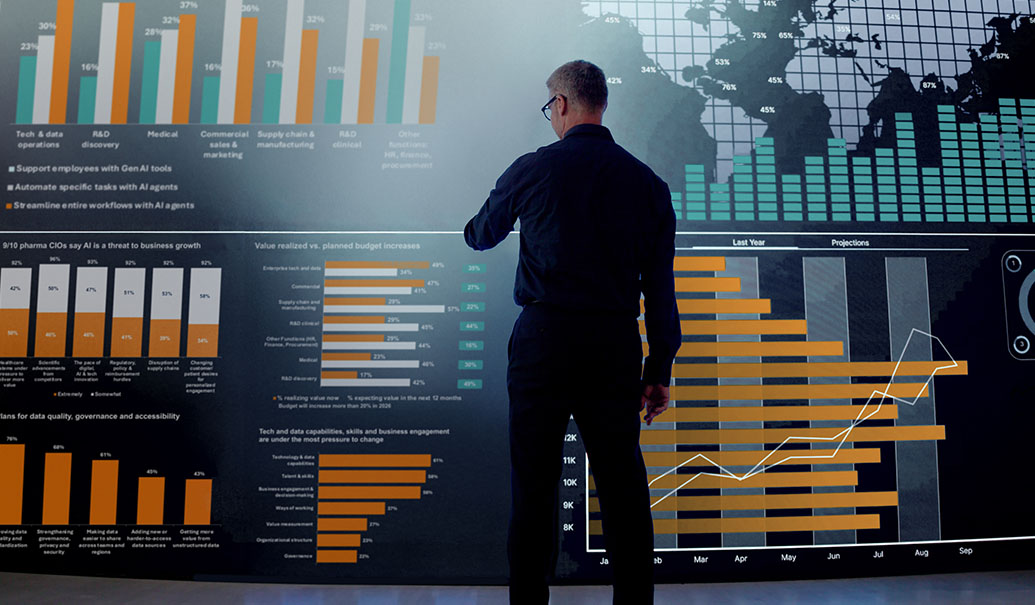With the universally accelerating data explosion, an ever-wider range of opportunities exists to leverage this data. Yet only around 25% of chief data officers indicate to have succeeded in creating a data-driven organization. Studies have shown that less than 50% of an organization’s structured data is used in decision-making. For unstructured data, this figure drops below 1%. Before adding more data into the mix, it is therefore critical to understand if there truly is a need for yet more data, and if so, for what exact purpose.
This prompted us to ask the question: “Do companies really need more data, and if so, to what end?” Our research looked beyond industries, functional areas and use cases. We focused instead on finding out the essence of what’s driving the demand. Our findings found the demand for more data was driven by the desire to do one or more of the following:
- Zoom in or out
- Operate in real time
- Isolate an impact
- Enrich context
- Improve accuracy
- Enable calibration
Below, we unpack each of the six demand drivers and contextualize them in the real world.
1. Zoom in or out
Data is required to drive the resolution of decisions. Data depth is required to drill down into a granular aspect of the business, and then data breadth is needed to fit the granular understanding into a wider pattern or context.
An example of this driver from recent history would be when CVS Health leveraged external data from vaccine suppliers and the Centers for Disease Control and Prevention to forecast supply and demand for COVID-19 vaccines when they became available in 2021. The company then used more granular data to determine precisely which geographical areas were underserved in terms of expected vaccination rates so marketing and logistical strategies could be enhanced appropriately.
2. Operate in real time
Data is needed to factor real-time (or near-real-time) events into decision-making for highly dynamic business problems.
Offering real-time sales assistance while customers are online browsing products or completing applications or transactions can help to improve the customer experience and drive conversion rates. To be able to provide the right assistance at exactly the right time, you need to receive a live data feed that helps you interpret where your prospective customer is in the sales cycle. Offering the advice too early, or providing irrelevant advice, might deter customers. In a recent study across 1200-plus companies, 64% of telecom businesses in the U.K. reported that implementing real-time data led to increased sales and a 94% positive feedback increase.
3. Isolate an impact
Data is needed to understand key levers and their relative importance in driving business performance, moving beyond spurious correlation.
A company’s marketing mix consists of product, price, promotion, place, packaging, positioning and people elements, all of which have an impact on a given product’s sales in a defined context. There are no examples where you can directly observe the impact of a change in any of these considerations because all things are never really equal in a practical sense. To be confident about the quantified effect of a promotional campaign or personalized pricing, you need data on the other aspects of the marketing mix as well as on other relevant contexts, such as inflation or consumer confidence.
P&G recognized that “you need to have a certain minimum amount of spend over a minimum period with a certain level of consistency, otherwise, it’s just tiny pieces of signal and noise all over the place, and you can’t isolate the signal from the noise anymore.” Gathering the right data over a sufficient amount of time then allowed them to “get really clear guidance on using 15 versus 30-second advertising for our mid-tier vs. premium-tier brands.”
4. Enrich context
Data is needed to contextualize business performance or customer behaviors in a more holistic way by bringing a 360 view to the problem statement.
Typical credit risk models banks use to predict the riskiness of giving an individual a loan (and to decide on giving the loan) in reality only rely on a very small set of financial indicators, such as the value of assets, credit card balances and previous defaults. These only describe an individual’s commitment to repay a debt to a very limited extent. They also exclude from the population the entire group of people that is “unbanked,” which means they don’t have any financial products or history.
To open this market segment and facilitate access to the financial market, some banks such as Banorte in Mexico are experimenting with alternative data sources, such as social media, telecommunications and psychometric surveys, to provide a much richer perspective on the customer. This type of data collecting enables them to make credit decisions without the traditional set of financial data, but it enriches their understanding of customers along dimensions that traditionally are not considered, such as where they went to school, what content they engage with and who they are connected with.
5. Improve accuracy
Data is needed for improving the accuracy of business decisions centered on predicting future performance or events.
Demand prediction has typically been achieved by looking at historical sales data, but when that prediction needs to inform local marketing campaigns, we’ve found in work with our clients that more data is needed to get them the granularity of insight they’re looking for. A hot dog brand, for instance, would want to leverage weather data, sporting event calendars, community calendars and localized web search data to understand the drivers of local demand for their product. That data could then be used to create models that would inform ad purchasing campaigns that have the optimal return on investment in that given market.
6. Enable calibration
Data is needed to benchmark a company’s performance against competitors and the industry at large. Conceptually, this driver is similar to the “isolate an impact” driver, but the focus switches from the independent variable(s) to the dependent one.
We see this driver in the electric vehicle market. The industry’s strong growth means achieving positive revenues growth is therefore not that insightful; rather, for a given producer, performance could be more meaningfully understood relative to other producers (market share, for instance), relative to an estimated addressable market, across regions and regionally relevant economic factors, and specifically across customer segments of future generations.
What’s driving your company’s need for data?
The same truism applies to data as it does to almost everything else: More isn’t necessarily better. To understand how your enterprise can leverage data to improve the business and customer impact, the six drivers described in this viewpoint serve as suggested levers. A good starting point can be to list and analyze your organization’s most critical data-driven use cases. For each, you can ask the question if more data can help to zoom in or out, operate in real time, isolate impact, enrich context, improve accuracy or enable calibration. This will lead to targeted opportunities to drive business value at a use-case level, but it will also provide input into possible business cases for data capabilities at an enterprise level. Moreover, finding the most appropriate lever that relates to your organization allows you to shift your focus to effective data collection to ensure you’re getting the insights you need for real growth.
Watch our in-depth on-demand webinar on this topic.
Add insights to your inbox
We’ll send you content you’ll want to read – and put to use.















